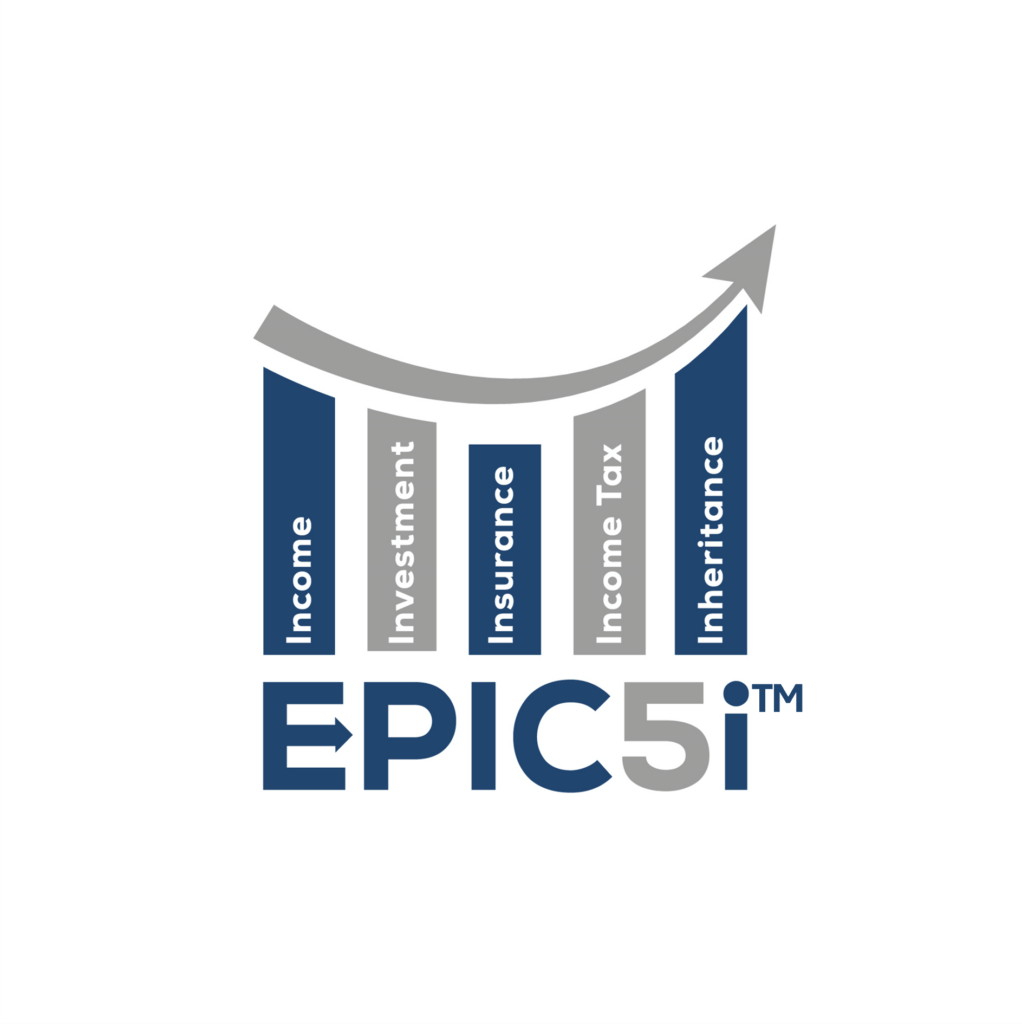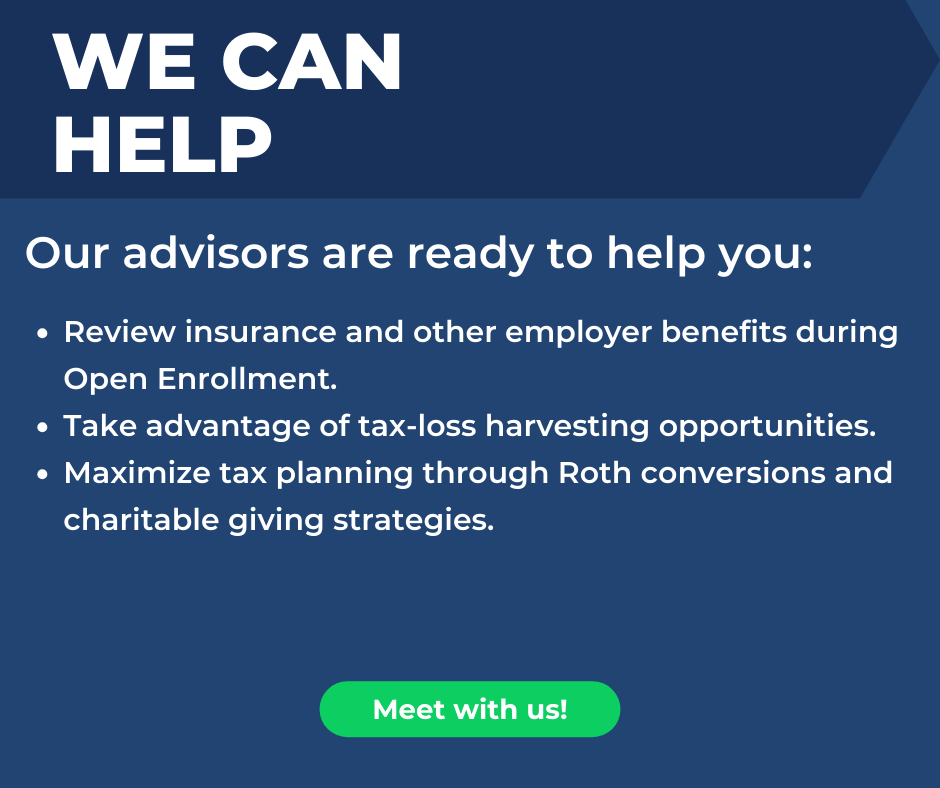2023 Year-End Planning Considerations
Written By: Shawn Perkins

The weather is getting colder, leaves are beginning to change color, and football season is in full swing. Fall is hands down my favorite time of year. Simultaneously, my job as a financial planner begins to ramp up while the year winds down. In addition to setting up my Halloween movie list – and yes, I have one (read on to find out more) – I’ve outlined out a few topics for us to consider before the December 31st deadline.
Open Enrollment
For those of you still working, Fall normally means the start of Open Enrollment season. Take this time to review the benefits offered by your employer and make any necessary changes. A few things to consider:
- Health insurance: Does it line up with your current or near-future needs and health status? Will you need to add a spouse or dependent to your coverage? Does your health plan offer a Health Savings Account through a High Deductible Health Plan, and if so, does that make the most sense for you?
- Life Insurance: Does your employer offer group term life insurance? This type of life insurance insures you while you’re employed through your current employer without going through underwriting and the cost is deducted from your paycheck. If you have this offering, how much life insurance do you need? It’s also advisable to have life insurance outside of your employer in the event you lose or switch jobs.
- Disability: Statistically speaking, we are more likely to experience an illness or injury that would prevent us from working rather than dying young. Review and consider the short- and long-term disability options offered by your employer. If none exist, it’s advisable to consider private coverage.
Tax-Loss Harvesting
If you have a brokerage account, i.e., a non-retirement investment account, you may have the opportunity to offset some of the gains in your investments by selling some of the investments that are currently at a loss. This is a practice referred to as “tax-loss harvesting” and is a tremendously powerful tool to preserve and grow a portfolio. If you’re going to do this, be careful of the wash-sale rule. The wash-sale rule is the prevention of taking a loss deduction on your taxes due to buying and selling the same security (or substantially identical security) within 30 days of each other.
Required Minimum Distributions (RMDs)
Required Minimum Distributions (RMDs) are the mandatory withdrawals that must be made from your qualified retirement accounts. The money that you have accumulated in your Traditional IRA’s or 401k’s over the years has grown tax deferred. Once you turn 73 years old (75 for birthdays 1960 and later), you must begin taking withdrawals and paying the subsequent tax. Failure to do so could result in a hefty penalty, so be sure to get this completed by the end of the year.
The RMD does not apply to your Roth IRA’s.
Roth Conversions
One way to help lower your future tax liability from RMDs is through Roth conversions. A Roth conversion is the process in which a security or cash within a Traditional IRA is moved from the Traditional IRA to a Roth IRA. This is a taxable event and is reported as ordinary income in the year in which the conversion takes place. Ideally, this would occur when taxable income is lower than it has been or is lower than what it will be in the future due to RMDs. Once these assets are within the Roth IRA, all growth takes place tax-free and is clear from any future tax increases. Keep in mind that a Roth conversion could result in other consequences in addition to higher taxes such as higher Medicare cost, loss of deductions or credits, and higher taxes on Social Security benefits.
Charitable Giving
One other way to lower your taxable income this year could be through charitable giving. Beginning at age 70.5, an individual can make a Qualified Charitable Distribution (QCD) from their Traditional IRA to a charity and that distribution will not be taxable. This strategy is particularly powerful once you reach your required beginning date. If your RMD will bump you into a higher tax bracket or cause an avoidable increase in Medicare cost, you could consider sending a portion of that RMD to a charity in the form of a QCD, lower your taxable income, and satisfy your RMD all at once.
For those not yet at RMD age, you could also consider gifting highly appreciated stock within a brokerage account to a charity. This method allows you to maximize the value of your charitable intent while not paying capital gains tax. This gift could be made to any charity, or to a donor-advised fund that you can set up yourself. However, with the rise in the standard deduction for all taxpayers, this method has put qualifying for a tax deduction further out of reach.
Gifting
Finally, the end of the year typically brings about the season of giving not only to charity but to family. In 2023, the annual gift amount is $17,000 per person. In other words, you can give $17,000 to as many people as you desire without having to file a gift tax return. And if you’re married, you can double that amount to $34,000. If you’re facing a potential estate tax issue at your passing, making annual gifts while you’re living could help reduce your taxable estate tax liability.
The year-end can be a very chaotic time with the holidays approaching. My hope is that you can use this as an informative guide to make sure you’re in the best possible position as we close out 2023. That way, you can enjoy this wonderful time of year, like I do.
Say What?
Shawn’s Top Five Halloween Movies:
- Halloween
- Hocus Pocus
- The Conjuring 1
- The Conjuring 2
- Insidious
Have any questions? That’s what we’re here for! Call us at 844-227-5766 today!
Get on our email list to receive these updates in your inbox!
Ready to Take The Next Step?
For more information about any of the products and services listed here, schedule a free assessment today or register to attend a seminar.

